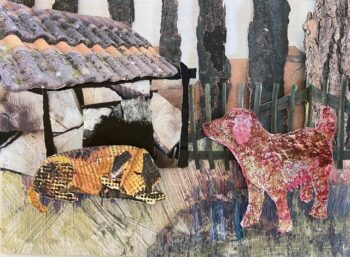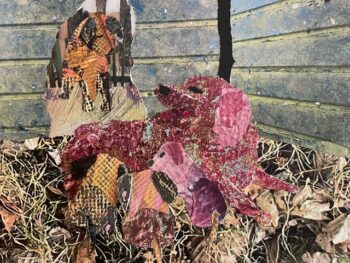Two Dogs
Annelie van Steenbergen, text and illustrations

Our country has thousands of homeless people, including an increasing number of women and young people.[1]
Can you imagine having to live under the bare sky like that? Or worse, that you are about to give birth and have no place to shelter and get proper care? That you have to have your child among the dirt, under a bridge or overpass. That you have no place to wash, and that the baby will be cold. You have no access to clean water and healthy food, no medical care. You are extra vulnerable to violence, abuse, theft. So what do you do? Do you visit your old circle of acquaintances and look for someone who has a spare guest room? You beg, on your bare knees if necessary, you flatter, you promise everything, flowers, chores, whatever. Just to be sure of a warm dry place where you can have your child.
This must have been how the stray dog fared that the ancient fable writer Aesopus (c. 620 – 500 B.C.E.) tells about in his ninth fable about two dogs.[2] He begins his story with a pregnant dog in bygone days who had to deliver.
‘When the time came, she came to the house of another dog and with fine words kindly urged her to give her a place in her house to throw her young.’
Without deliberating at length or discussing with lawyers what consequences her decision might have, her friend strokes her heart and makes her house and bed available. She understands that her companion is in acute need of help. She consents, according to Aesopus ‘in the opinion of doing good there’.
Although Aesopus does not describe it that way, it is likely that she comes occasionally to see if all is well. She admires the little puppies, brings a strengthening toy for the exhausted mother and waits patiently until the little ones are weaned, can go outside and search for food on their own. Meanwhile, she herself sleeps outdoors, in the rain and wind, in the shelter of a wall or in a hole under a fallen tree. Once she considers that the mother can now continue to take care of herself, she asks her to leave the house. Then she gets the member on the nose. Aesopus says:
As soon as the mother and the boy heard this, they attacked her very furiously and threw her out of her own house.
For Aesopus, who always begins and/or ends his fables with a moral, this is a typical example of bad people’s behavior. You should not get involved with them. Because, he says:
This is how it goes: by doing good you often experience harm.
And he adds, as a warning:
Also, good people often lose their property through the deceit of bad people.
According to Aesopus, this fable teaches us
that it is not good to believe the flatteries of bad people, because by their fine words they deceive good people.
Aesopus thus makes a sharp distinction between wrong and right.
On first reading, this seems like a simple fable, with an unambiguously understandable moral. On closer inspection, however, it is quite a complicated subject, which cannot be judged at first sight. There are all sorts of hidden meanings.
Jean de La Fontaine (1621-1695), who put many of Aesopus’ fables into rhyme and adapted them to his times, puts it right on the line in his fable The Hunter Dog and Her Comrade. [3]The original title is La Lice et sa Compagne. The translation of La Lice is ambiguous. The dictionary gives both “shed” and ‘battleground’ and ‘female hunting dog, a female intended for breeding’. These are appropriate meanings, as the search for a doghouse turns into a bitter fight.
The first sentence of this fable is interpreted by the translator as follows:
The hunter-dog’s wife
walking on her last legs,
was desperate to have her baby’s born.

This throws a different light on the story. It is not a vague acquaintance seeking refuge, as in Aesopus. It is the female hunter’s dog. She asks the favor of the puppies’ sire, their father.
She humbly asks her comrade to lend her his pen, since it is currently empty anyway and she urgently seeks living quarters for the delivery. It is only for one week, she presses him to his heart. He immediately grants her wish with a “Fiat!” A week later he returns to reoccupy his house. Then it turns out she really can’t leave yet.
Oh, lend me your house for another fortnight
‘t is not for myself, that I ask for it:
My young ones are in extra-need,
And weak on their feet!
And the father is clever enough to give his permission. After all, he can’t send those children away when they can’t yet stand on their own two feet. So he gives them respite.
When he arrives on the agreed-upon time to ask if they would be so kind as to vacate and leave the house, he sees the mother and her tipsy rascals with fearfully raised lips and gnashing teeth growling at the entrance.
If ye dare, ye comrade,
Put with my boy me in the street!

The brood was already too strong to do anything to them without danger, says De La Fontaine.
So the moral at the conclusion of his fable is that a villain answers the good with ingratitude. To get back what you have lent, you have to argue, put up a fight, and usually that ends in harm or disgrace.
Whom thou hast given a finger this day
Tomorrow bites thy whole hand away!
As before with Aesopus, it seems a foregone conclusion who is the culprit here.
At first glance, fables appear to be harmless animal stories, where the bestial behaviours can be transferred one to one to typical human traits in order to arrive at a judgement. The purpose of the fable is to teach the reader a wise lesson. However, fables are political too, both those from Aesopus’ antiquity and from early modern times and our own.
This fable, for example, opens up a whole arsenal of possible issues about housing, very reminiscent of today’s shortage of sufficient affordable rental housing. Once you begin to ponder this fable you are confronted with the question of where you stand on the political spectrum, whose side you sympathize with. Are you perhaps an unwed mother, or do you still live with your parents as an adult? Are you perhaps a victim of domestic violence? Are you an indigent elderly person, a single person with children, or have you had to leave your home due to divorce. Are you a refugee who has been waiting in vain for years for a safe place to live? Or are you at the other end of the spectrum, living in a large house with vacant spare rooms? In that case, should you feel morally obligated to provide temporary housing for a desperate housing seeker? And if you do, can you then forcibly evict your guests back onto the street at some point if they refuse to leave within the agreed upon time frame?
In this fable, the outcome is brought to a head by the aggression of the mother and bloodthirsty children. Why go to war right away? Because they are ‘bad’ people, as the fable writers claim? Or does the fear of not being able to shelter her children prevail and, in her opinion, attack is the best defense?
It would have been more effective if the worried and frightened mother had not resorted to a physical attack to get her way, but had actively and with outside help sought a satisfactory alternative, perhaps with the cooperation of her comrade.
In normal life, a reasonable solution should be found so that the owner of the property can fend for himself without having to evict the mother and children. In that case, it is not enough just to show empathy and compassion, it also takes caring and an outstretched hand offering alternatives.
Due to the current housing shortage, people with residence permits and other housing seekers are sometimes forced to share housing with others, often strangers. This demands a lot from residents. A violent action to annex someone else’s home is not the solution, and in practice this rarely occurs. There are plenty of examples of people who, to their mutual satisfaction, welcome, for example, status holders into their homes for an appropriate period of time and maintain warm friendships with them. And should problems arise, there are better ways than war and strife to reach a solution, as in the fable about the two dogs.
It is clear on which side of the political playing field Aesopus and De La Fontaine stand: above all, do not give help to the needy if you are in danger of becoming a victim yourself.
However, a middle road and common ground are necessary, without either party having to give up their own existence and happiness in order to do so. Without an address, it is difficult to find work or study, to get insurance against accident and illness. A safe place to live is an important basis for everyone’s life.
Old fables still prove relevant, even for our time. How do we ourselves think about them? In other words, what lessons can we draw from them, even if they differ from those taught by the fable tellers of the past? What would be our response on both sides of La Lice, of the battleground? How far does our own sacrificial spirit extend? Where does our helpfulness clash with the law of self-preservation? All fascinating issues to ponder as you read this fable about the Two Dogs.
Noten
[1] On January 1, 2024, an estimated 33 thousand people between the ages of 18 and 65 were homeless in the Netherlands. Retrieved 15-05-2025 fromwww.cbs.nl.
[2] Taken from the Dutch edition: Het leven en de fabels van Esopus. Teksteditie met inleiding, hertaling en commentaar door Hans Rijns en Willem van Bentum. Hilversum: Verloren, 2016, p. 171-172.
[3] Taken from the Dutch edition: Jean de La Fontaine (nagevolgd door J.J.L. ten Kate) (1875, ?, 1e druk)- De fabelen van La Fontaine. Geïllustreerd met platen en vignetten door Gustave Doré. Fabel VII, Tweede boek. Amsterdam: Gebroeders Binger, pp. 83-84.
